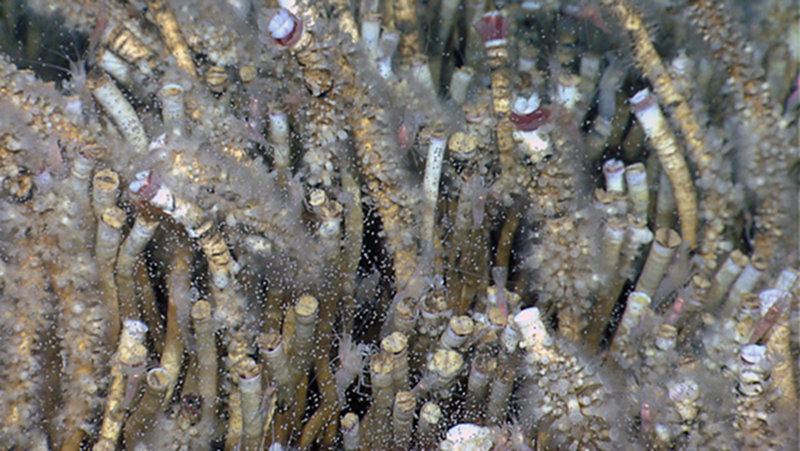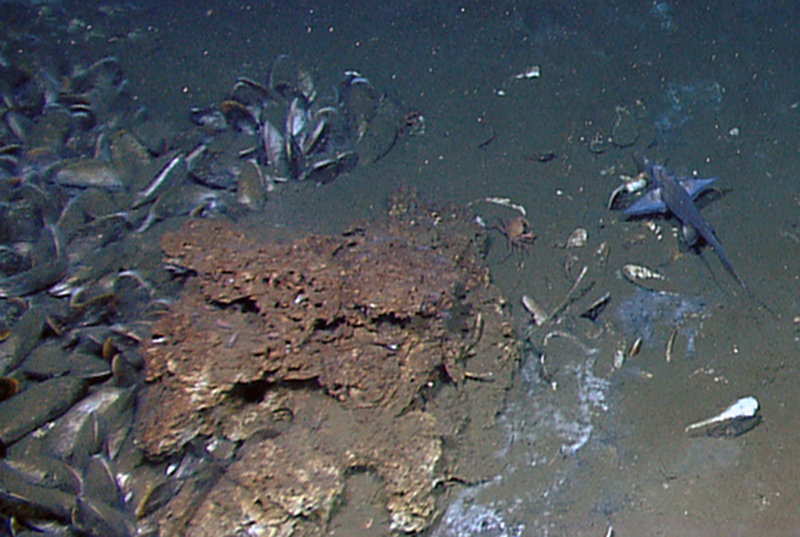
By Erin Becker, Community Ecologist
April 20, 2012

Figure 1: An aggregation of vestimentiferan tubeworms (Lamellibrachia sp.). Such aggregations provide habitat for many smaller animals such as the small white anemones covering the tubeworm tubes and the shrimps Alvinocaris muricola. Image courtesy of the NOAA Office of Ocean Exploration and Research, Gulf of Mexico Expedition 2012. Download larger version (jpg, 1.3 MB).
During yesterday's dive, we searched for natural hydrocarbon seeps — areas where oil and natural gas slowly leak out of the seafloor. This is an entirely natural phenomenon and an important characteristic of the Gulf of Mexico ecosystem. Just as oil and gas provide energy to power our modern society, these chemicals provide energy to support dense animal communities. Although seeps account for a much smaller area of the seafloor than the completely flat mud bottom that characterizes the majority of the Gulf, they are still quite common and contain an astounding density of life within a relatively small area. Because of the patchy distribution of hydrocarbon seepage, seep communities have been described as 'oases' of primary productivity in an otherwise food-poor deep sea. However, the degree to which seep communities represent isolated 'islands' having very little interaction with one another and the rest of the Gulf of Mexico ecosystem is unknown. Thus, studying the interactions among animals within seep ecosystems, especially food web interactions, is important to the understanding of the function of seep ecosystems and how they fit into the broader Gulf of Mexico ecosystem.
Video footage captured by the Little Hercules ROV and camera platform during the April 20 ROV dive from NOAA Ship Okeanos Explorer during the Gulf of Mexico Expedition 2012. The dive was conducted in Green Canyon at lease block Ewing 915. Spectacular undersea habitats and geologic features were imaged, including a brine pool, brine "river", and small cones composed of what may be precipitated salts emitting gas, probably also mixed with liquid hydrocarbons. Video courtesy of the NOAA Office of Ocean Exploration and Research, Gulf of Mexico Expedition 2012. Download (mp4, 397.2 MB).
Vestimentiferan tubeworms and bathymodiolin mussels dominate biomass in seep communities. These animals have symbiotic bacteria living inside their bodies. Through chemosynthesis, the bacteria harness energy from the chemicals in seeping fluid to produce food for their host, much like plants harness the sun's energy to produce food via photosynthesis. These animals, in turn, provide habitat for an entire community of smaller animals, including shrimp, squat lobsters, brittle stars, anemones, and polychaete worms. Interestingly, there is no evidence that any of these animals are actually eating the mussels or tubeworms. Instead, the associated animals get their energy from free-living bacteria that harness chemical energy in the same way as the symbiotic bacteria.

Figure 2: A chimera fish and golden crab (Chaceon sp.) near a clump of seep mussels. These animals spend much of their lives wandering the barren mud bottom of the Gulf of Mexico, but occasionally visit seeps. They could be important agents in transferring energy from seeps to the greater Gulf of Mexico food web. Image courtesy of the NOAA Office of Ocean Exploration and Research, Gulf of Mexico Expedition 2012. Download larger version (jpg, 1.0 MB).
Recently, scientists collected whole aggregations of tubeworms and mussels, and their associated communities. This study showed that most of these smaller animals feed within a single mussel or tubeworm aggregation (as opposed to jumping tens to hundreds of meters from one to another). This supports the 'oasis' or 'island' analogy — at least for those animals that spend most of their lives at seeps. There are still some missing links that would help complete the picture of how energy is transferred from bacterial primary production through the seep food web and beyond.
One link is meiofauna – very small, sometimes microscopic animals such as nematodes and copepods (figure 1). These tiny creatures are likely to be an important link in the transfer of energy from chemosynthetic microbes to higher predators. Another is the export of seep primary production to the surrounding deep-sea ecosystem. It is not uncommon to see fish and larger benthic (bottom dwelling) crabs "visiting" (figure 2). These animals spend most of their lives away from seeps, but may feed on seep-associated animals before moving on. It is hard to measure how much energy leaves the seep ecosystem, because fish and large crabs are less common in these habitats than the resident animals and are difficult to capture. Additionally, seep nutrition may make up a very small amount of the diet of one individual fish, so that it is difficult to detect. However, many fish, each carrying away a small amount of seep material, could be quite significant in transferring energy from seeps into the greater Gulf of Mexico food web.